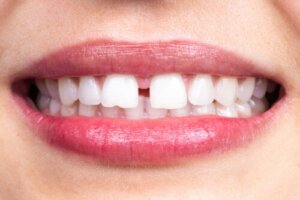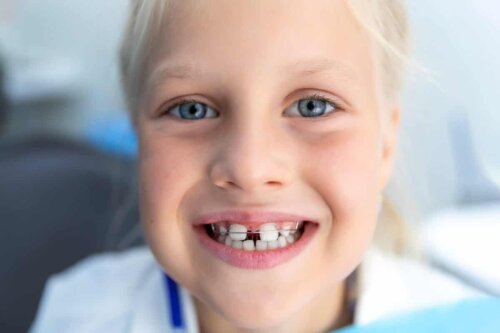Characteristics and Causes of Dental Diastema


Written and verified by the dentist Vanesa Evangelina Buffa
Dental diastema is the term used to describe the excessive gap between teeth. The separation between the upper central incisors is the most common and visible. It’s also the best-known one thanks to some celebrities who show it with pride.
Today’s article will describe why it happens and how to correct it if a person just can’t live with it.
Read on to find out more!
What’s dental diastema?
As we mentioned above, a dental diastema is an excessive gap between two or more teeth, and the most common is between the upper central incisors.
It can happen between any pair of teeth, both in the temporary and permanent dentition — in children and adults.
Why does dental diastema occur?
Different factors can lead to the presence of dental diastema but the most frequent are:
- Age: This condition is common in the first set of teeth of young children. It usually corrects on its own as they grow up and closes with the eruption of the secondary dentition.
- Genetics: This trait is a family characteristic passed from generation to generation.
- A discrepancy between the size of the bone and the size of the teeth: This is due to a particularly large jaw or small teeth that leads to the spacing between teeth.
- The absence of a tooth often leads to spacing with the next tooth.
- The presence of an extra tooth, a mesiodens, is a conical or double cone-shaped micro supernumerary tooth located between the central incisors or behind them. Its presence, even if it remains retained inside the bone, causes separation of the teeth.
- Large or fibrous labial frenulum: This is the mucous membrane that extends from the inside of the lip towards the gingival tissue. It can be lower or higher than the standard and cause the separation of the central incisors.
- Tongue thrusting: This is the habit of pushing the teeth with the tongue and can cause long-term separation.
- Trauma: An untreated blow to the mouth can lead to the displacement of the teeth and create a gap.
- Bite alterations: Oral alignment problems, horizontal overbite, and protruding teeth are all causes of dental diastemas.

Consequences of dental diastema
Oftentimes, having a dental diastema doesn’t mean any serious inconvenience other than the aesthetic. This isn’t a problem for some people but is a source of embarrassment to others. In fact, it can harm their self-esteem and social relationships.
There are other consequences associated with dental diastema though. For one, the increased risk of caries and gingivitis in the teeth involved. This is because the gap allows the accumulation of bacterial plaque and food debris. In addition, inadequate oral hygiene can lead to the development of these diseases.
Diastemas can be due to occlusion problems that affect a person’s bite. In addition, there’s the possibility of headaches, earaches, jaw and neck pain.
Speech disturbances are another possible consequence. This is because it leads to the improper pronunciation of certain phonemes involving the front teeth.
Learn about the Types of Dental Bridges and Their Advantages
Alternatives to correct it
The first step in correcting a dental diastema is to determine its cause. Then, plan the appropriate treatment based on this. Any dentist should be able to guide their patients on the most appropriate alternatives for their individual cases.
These are some of the therapeutic options:
- Keep the diastema. A patient who feels comfortable with the aesthetics of their smile doesn’t require intervention. Especially if it doesn’t affect the function and there’s no risk of associated conditions.
- Closing the space with orthodontics by moving the teeth to close the gap. The patient may require conventional, esthetic, lingual, or invisible braces.
- Dentists can reshape teeth by adding esthetic resin-based material to close the gap.
- Dental porcelain veneers can be another solution when bonded to the outside of the teeth. This is mainly to give them a larger appearance and close the gap.
- Crowns give a new shape and size to the tooth and thus close the excessive gap. A technician must mold it to place and cement it as a cap to completely cover it.
- Cut and reposition it through frenectomy, a surgical procedure, when the diastema is due to the labial frenulum. It should also be surgically removed if the cause is the presence of mesiodens. The gap might close on its own when performing these interventions in children. However, the treatment must be combined with orthodontics to complete the closure in teens and adults.
- A dental diastema caused by trauma requires immediate action. The dentists must numb the tooth and reposition it in its correct location. They’ll probably fix it in place with splints for some period of time.

Read about The Main Dental Problems in Children
At ease with your smile
Having a dental diastema can be an obstacle to pronounce certain phonemes, or a source of embarrassment when smiling. Thus, consult a dentist con can determine the origin and prescribe the best available solution.
Furthermore, some people are comfortable with their tooth gap, see it as a special feature, and smile with pride.
Whatever the case may be, feeling good about one’s own image is important. Thus, consult a dentist to clear any doubts you might have. There should be no obstacles to a confident smile.
All cited sources were thoroughly reviewed by our team to ensure their quality, reliability, currency, and validity. The bibliography of this article was considered reliable and of academic or scientific accuracy.
- de Medeiros, Mikaelly Fernanda, et al. “Tratamento de frenectomia labial com indicação ortodôntica: relato de caso.” ARCHIVES OF HEALTH INVESTIGATION 7 (2018).
- Bejar Cherres, Verónica Raquel. Frenectomía labial superior en pacientes de 25 años de edad. BS thesis. Universidad de Guayaquil. Facultad Piloto de Odontología, 2019.
- Pérez Balladares, Jennifer Antonella. Manejo ortodóntico del diastema causado por frenillo en pacientes adultos. BS thesis. Universidad de Guayaquil. Facultad Piloto de Odontología, 2018.
- Chacón-Moscoso, Alicia, Rocío Baños-Lara, and Renata De La Hoz Perafán. “Frenillo labial en el tratamiento de ortodoncia.¿ Su eliminación, antes o después del tratamiento?.” Oral 17.55 (2018): 1398-1403.
- Mateu, F., and Ignacio Cañameras Autrán. “Cierre de diastemas. Clasificación y técnicas con composite.” Gaceta Dental: Industria y Profesiones (2011).
- Romero, Mario F., et al. “A multidisciplinary approach to the management of a maxillary midline diastema: A clinical report.” The Journal of prosthetic dentistry 119.4 (2018): 502-505.
- Gil, Alain Manuel Chaple, et al. “Cierre de diastema con resinas compuestas híbridas.” Rev Cubana Estomatol 53.1 (2015): 56-62.
- Dehghani, Mahboobe, and Farzin Heravi. “Orthodontic-restorative treatment of maxillary midline diastema.” Dental Hypotheses 5.3 (2014): 124.
- Arocha, Boris Abel González, Kirenia Pieri Silva, and Bárbara Ledesma Cañellas. “Cierre de diastema central superior. Presentación de un caso clínico con enfoque multidisciplinario.” Revista de Enfermedades no Transmisibles Finlay 5.4 (2015): 275-283.
- Kabbach, William, Camila S. Sampaio, and Ronaldo Hirata. “Diastema closures: A novel technique to ensure dental proportion.” Journal of Esthetic and Restorative Dentistry 30.4 (2018): 275-280.
- Villa Molina, Jorge Andrés. “El diastema maxilar de linea media: Una revisión para tratar pensando en la estabilidad.” (2021).
- Guzmán, Leonardo Tirado, Beatriz Gurrola Martínez, and Adán Casasa Araujo. “Cierre ortódoncico de diastemas en paciente adulto.” Leonardo (2020).
This text is provided for informational purposes only and does not replace consultation with a professional. If in doubt, consult your specialist.








